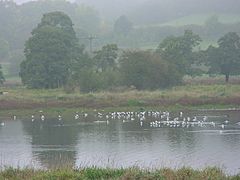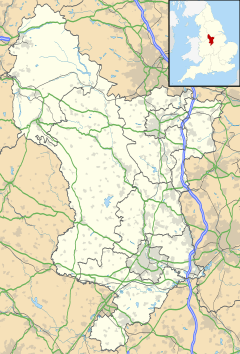Wyver facts for kids
Quick facts for kids Wyver |
|
|---|---|
 Wyver Lane Nature Reserve |
|
| OS grid reference | SK342499 |
| District |
|
| Shire county | |
| Region | |
| Country | England |
| Sovereign state | United Kingdom |
| Post town | BELPER |
| Postcode district | DE56 |
| Police | Derbyshire |
| Fire | Derbyshire |
| Ambulance | East Midlands |
| EU Parliament | East Midlands |
Wyver Lane Nature Reserve, also known as Wyver Lane Pool Reserve, is a special place for wildlife. It is located west of the River Derwent and just north of Belper. This reserve covers about nineteen acres (that's like 14 football fields!). It's also part of the Derwent Valley Heritage Way, a long path for walking and exploring.
The reserve is on a flood plain, which means it sometimes gets covered by river water. This makes it a perfect home for many animals, especially birds that like wet areas, like wading birds. The Derbyshire Wildlife Trust manages this area. They lease it from Amber Valley Borough Council. It's one of the most important wetland nature reserves in Derbyshire.
To keep the birds safe and happy, people are not allowed to walk onto the reserve itself. The reserve has two main pools. These pools are surrounded by wet meadows and tall reed beds. Many different kinds of birds have been seen here over the years!
Contents
Discovering Wyver Lane's Past
How the Pools Were Formed
Long ago, in the 1700s, a mill was built in Belper. To power the mill, people built a dam on the River Derwent. They also raised the river bank north of the mill. This was to stop the river from overflowing.
But the river still broke through many times. Each time it flooded, it created new pools of water. These are the pools you can still see at the reserve today.
Military Training Area
Later, the area was used for shooting practice by soldiers called the Territorials. You can still see parts of their old firing range. There are old walls, called buttresses, that were used for protection. One of these walls is now an island in the main pool.
There's also an old metal gate post near the viewing mound. The Territorials used it to show if the area was safe. A green flag meant it was safe to pass. A red flag meant it was not safe because shooting was happening. A little further down the lane, you can see a brick building. This was where they stored ammunition. The soldiers also used to pump water out of the land into the river. The pump house, a brick building with a big pipe, is still there at the south end of the reserve.
From Tip to Nature Reserve
After the soldiers left, the Amber Valley Council used the land as a rubbish tip. This was before there were strict rules about what could be dumped. Thousands of tons of rubbish were buried there. This pushed the water upwards, creating even bigger pools.
The tip closed in the 1970s. Since then, the area has become a peaceful nature reserve. The water levels in the pools are now controlled. There's a special gate, called a sluice, at the south end of the main pool. There's also a pipe that connects the main pool to the river. In winter, this pipe is blocked to keep the water high for winter birds. In spring, it's opened again. If summer is dry, the water levels drop. This helps attract wading birds in late summer or autumn.


